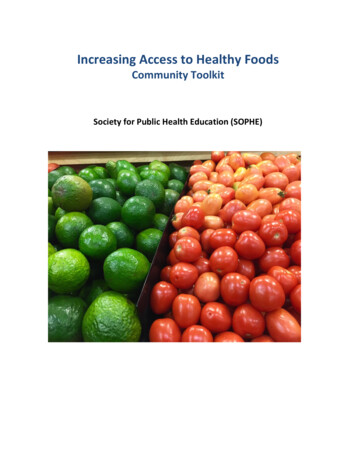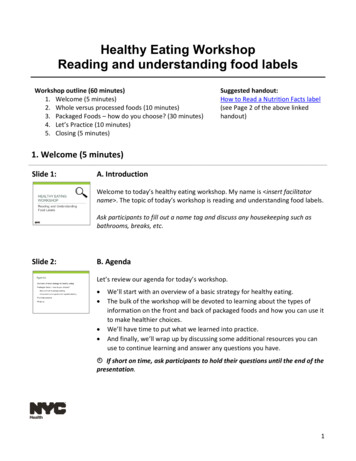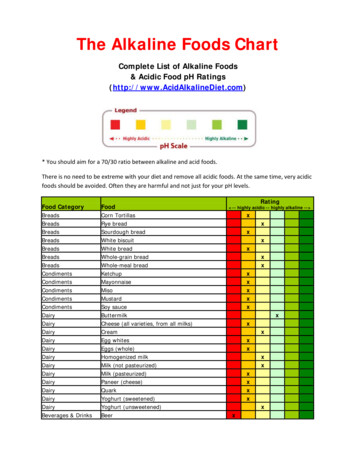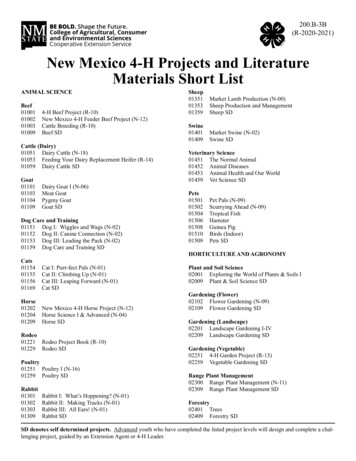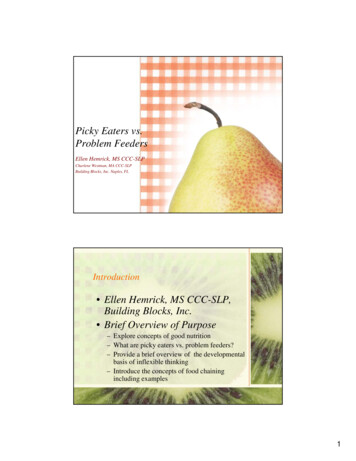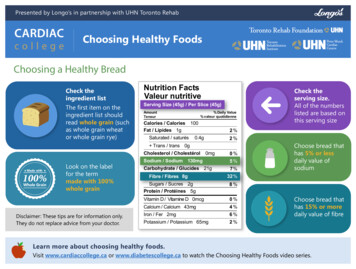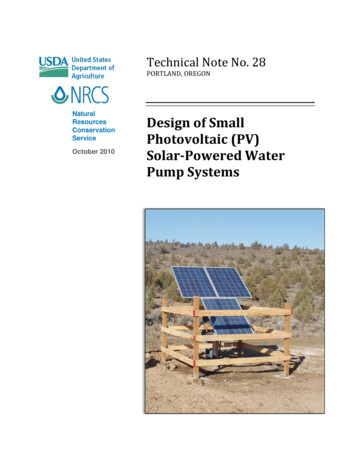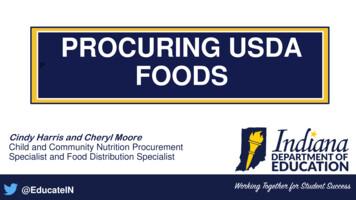
Transcription
PPROCURING USDAFOODSCindy Harris and Cheryl MooreChild and Community Nutrition ProcurementSpecialist and Food Distribution Specialist@EducateIN
What will make this trainingworthwhile? Introduce yourselves to your table group.Collaborate on a team name for your group that pertainsto USDA Foods.Discuss the variations of school sizes in the table group.Discuss some specific information that your group hopesto get from this training.Report to the training group one topic that was discussedthat the table group hopes to get from this training.@EducateIN
Overview What are USDA Foods?EntitlementForecastingBuy AmericanProcurement ProceduresPre-order SurveyManaging Inventory at the Warehouse and ProcessorDoD FreshCNP Web@EducateIN
Questions and Index Cards@EducateIN
What Are USDA Foods? USDA Foods are foods purchased by the USDA from the American agricultural industry and donated toRecipient Agencies (RAs) for use in their food service operation to support school nutrition assistanceprograms. USDA Foods account for 15-20% of the school food budget. RAs must still purchase food commercially.@EducateIN
What is my role in USDA Foods?Each of us bear responsibility to ensure the integrity and effectiveness of the programUnited StatesDepartment ofAgriculture(USDA)Procurement andadministration@EducateINIDOE(State DistributingAgency or SDA)AdministrationInventorymanagementOrder processingRecordkeeping andmonitoringRecipient Agency(RA)Effectively usingtheir entitlementdollars, inventorymanagement, gement,reporting andrecordkeepingDistributorsinventorymanagement, billingand recordkeeping
Entitlement This is based on the number of lunches served in the prior school year X the per meal rate. This is the amount of dollars you can spend up to 102 percent. Food can be purchased based on the participating school/Recipient Agency’s (RA’s)entitlement. This screen also shows the allocations that have been made for the year. Breakfast and after school care snack data is not included in the Planned Assistance Level(PAL) calculation. However, USDA Foods may be used for these meals.@EducateIN
Entitlement – 12 Percent Provision If at least 12% of all NSLP federal dollars the state receives are not in the form of USDA Foods, then thegovernment makes up the difference which is fair-shared to each state. The provision only applies to National School Lunch Program and no other program.A per-meal rate is established by FNS each July and published in the Federal Register. This rate is calculatedbased on the Bureau of Labor Statistics’ Producer Price Index for Foods Used in Schools and InstitutionsLunches servedXCurrent per meal rate 12% provision Entitlement@EducateIN
Ways To Use/Spend PAL Or Entitlement Direct Delivered (AKA brown box)– deliveries made biweekly by your state contracted warehouse, Dilgard,McFarling, Stanz or Wabash.Direct Diverted – bulk products diverted to processors forfurther processing into ready to cook/eat items.USDA Department of Defense (DoD) Fresh Fruit andVegetable Program – voluntary program that RA commits aportion of their entitlement to purchase fresh fruits andvegetables.All attempts must be made to use food purchased withentitlement funds in the year it was purchased.@EducateIN
What Is Direct Delivered? Products are delivered from USDA or USDA vendors toyour state contracted warehouses.Deliveries made bi-weekly to schools by your statecontracted warehouse, Dilgard, McFarling, Stanz, orWabash.As these items are allocated, they are drawn down andtracked in CNPweb.They are distributed in cases.@EducateIN
What Are Direct Diverted Products? Bulk products diverted to processors for further processing into ready tocook/eat items. For example, converting raw/bulk chicken into chickennuggets.These are distributed in pounds.They need to be tracked in the commodity tracking websitesK12Foodservice.com and ProcessorLink.Processors must be procured.RAs must utilize their previous school year’s diverted USDA Foodsinventory by June 30 of the current school year. Don’t order more product ifthe current balance is unused.@EducateIN
What is the USDA DoD Fresh Fruit andVegetable Program? A voluntary program in which RAs divert a portion of their entitlement topurchase fresh fruits and vegetables.IDOE usually requests commitments from schools via email in lateNovember.This program is not managed by IDOE. We only handle the entitlementtransfers and deductions from PAL.The current state vendor is Creation Gardens in Louisville, KY.To place orders, schools must obtain E-Authentication and login access toFresh Fruits and Vegetables Order/Receipt System (FFAVORS). Aminimum order of 150 is required.Not the same as the Fresh Fruit and Vegetable Program (FFVP).DoD Fresh dollars must be spent by June 30 each year.@EducateIN
USDA Department of Defense (DoD) FreshFruit and Vegetable Program The USDA manages this program and DoD Defense Logistics Agency (DLA)manages the procurement contracts and performance of produce vendors. All produce offered through this program must be grown in the United States.These are “local” fruits and vegetables. DoD defines local as from within thestate and the adjacent states. RAs indicate the amount of their entitlement they wish to spend (usually inNovember) toward DoD Fresh and IDOE draws it down before the annualpre-order survey opens in January. Complaints should be directed to the DLA representative, vendor and statedistributing agency.@EducateIN
Forecasting Identify the products and quantities you will beprocuring.Estimate the total cost of the products andquantities.Your menu drives your USDA choices!@EducateIN
Buy American Provision 7 CFR 210.21(d) Requires the SFA to purchase, to the maximum extent practicable, domestic commodities orproducts. Applies to SFAs located in the 48 contiguous United States and is one of the procurementstandards SFAs must comply with when purchasing commercial food products served in theschool meals program. All procurement transactions for food when funds are used from the nonprofit food serviceaccount, whether directly by an SFA or on its behalf, procurement transactions must complywith the Buy American provision. Buy American provision should be included in documentedprocurement procedures, State agency prototypes documents, and all procurementsolicitations and contracts. There are limited exceptions to the Buy American provision: The product is not produced ormanufactured in the U.S. in sufficient and reasonably available quantities of a satisfactoryquality; or competitive bids reveal the costs of a U.S. product are significantly higher than thenon-domestic product.@EducateIN
Buy American; Provisions-ExceptionAlternatives Are there other domestic sources for this product? Is there a domestic product that could be easily substituted, if the nondomestic product is less expensive (e.g. substitute domestic pears fornon-domestic apples)? Am I soliciting bids for this product at the best time of year? If Icontracted earlier or later in the season, would prices and/or availabilitychange? Am I using third-party verification, such as through USDA AMS, todetermine the cost and availability of domestic and nondomestic foods?@EducateIN
Regulations 2 CFR Part 200 7 CFR Part 210 (NSLP) 7 CFR 225 (SFSP) 7 CFR 226 (CACFP)www.ecfr.gov@EducateIN
Procurement Thresholds1. Micro Purchase (Under 10,000*)-Equitably distribute amongqualified suppliers2. Small Purchases (Between 10,000* - 150,000 Indiana) 3Quotes3. Large Purchase (Over 150,000 Indiana) – IFB or RFP4. Non-Competitive Proposal (Very Rare)*Federal Thresholds Changed, June 2018Micro Purchase(Under 10,000)Informal Threshold(Under 250,000)YOU CAN ALWAYS USE THE MORE RESTRICTIVE METHOD@EducateIN
Language to Include for RFP/IFP Termination for cause and convenience (Contracts over 10,000) [2 CFR 200 Appendix II/7 CFR3029.48] Equal Employment Opportunity (Contracts over 10,000) [Appendix II to 2 CFR 200/7 CFR3019.48] Contract Work Hours/Safety Standards Act (Contracts over 2,500) [40 U.S.C. 3701-3708] David Bacon Act (Construction contracts over 2,000) [Appendix II to 2 CFR 200/7 CFR 3019.48] Rights to Inventions Made Under a Contract or Agreement (if applicable) [Appendix II to 2 CFR200/7 CFR 3019.48] Debarment and Suspension [Executive Orders 12549 and 12689)(2 CFR Part 200.213 andAppendix II to 2 CFR Part 200 (I) (All contracts)] Byrd Anti-Lobbying Amendment [31 U.S.C. 1352)(Appendix II to 2 CFR Part 200 (j)(Contracts worthover 100,000] Buy American [7 CFR Part 210.21(d)/FNS Policy Memo SP 38-2017]@EducateIN
BreakLet’s take a 10 minute break.@EducateIN
Pre-order Survey This is your school’s request for USDA Foods items you plan to menu during the upcomingschool year. There is no guarantee that USDA will buy or deliver items requested by the States. Based on USDA’s Foods Available ListThis is where you spend your school’s entitlement.Opens annually in CNPweb in late January and closes in mid to late March.Both direct delivered and diverted products choices are made on the same survey.USDA Foods should be requested y in quantities that can be consumed without waste.After the Pre-order Survey is complete it will be determined if the state can meet volumerequirements for an item, or if USDA will be able to purchase the requested items.@EducateIN
Preparing for the Pre-Order Survey Start Planning Early How much do you have on hand (i.e. at your school, warehouse rocessorlink.com/Be sure you complete production records daily and refer to them.Review Order history and previous surveysUse Planned menus – such as cycle menusCalculating Ordering Amounts WorksheetUSDA Food Buying Guide@EducateIN
Pre-Order SurveyPlan, Plan,Plan!
Pre-Order SurveyNo,Seriously You need toPLAN!
CNPWeb This is where you find the puzzle pieces.RAs go here to place USDA Foods orders to be delivered to theirschool sites, enter reimbursement claims, and updateinformation.Every school approved for the National School Lunch Program(NSLP) has a login and password for the school. Not individually.https://scnweb.doe.in.gov/Our focus will be the green puzzle piece for this course.@EducateIN
CNPWeb-Message ScreenRegularly check the update and message screen for importantinformation. After clicking Continue at the bottom of the page, clickthe appropriate Program Year. Then you should land on the RASummary Page.@EducateIN
CNPWeb-Applications Tab Go here to update FSD contact information and also click box #29 on this page when it’s time torecertify. The image to the right shows the RA Information Sheet. RAs can see all their sites listed under their sponsor number. **Note—Even if the name of the Food Service Management Company is listed, the RA is the ownerand responsible for all USDA Foods.@EducateIN
CNPWeb-Entitlement Tab This is your school’s total amount available to spend on USDA Foods. It equals the number oflunches served in the prior school year x the per meal rate IDOE wants schools to spend up to 102 percent of the entitlement amount. This screen also shows the allocations that have been made for the year. It also shows pre-allocations such as the amount diverted to the USDA DoD Fresh program.@EducateIN
CNPWeb-Surveys Tab This is where you enter your pre-order survey choices. Both brown box and raw products are done on the same survey. Pricing for survey products is available each year from the November file from USDA. Click the view button. The next slide shows what you will see.@EducateIN
CNPWeb-Surveys Tab (cont’d.)The Survey Results screen shows: Name of the school sponsorThe expected product for entire year or by month.Both raw products sent to the processor and directdelivered. The product code with blue links, which are highlighted here, are items sent to the processor. You must click the blue link toget processor information.The product codes in black are direct delivered.The Fill and Bal columns – this is where the productsare drawn down once allocated. For example, in the bal column there are 10 cases of 100012cheddar cheese and 0 in the fill column. This means this schoolis still waiting for cheddar cheese to be delivered. Remember bulk pounds are not drawn down in CNPweb.@EducateIN
CNPWeb-Allocations Tab Food items are allocated weekly based on the RAs survey. To add surplus (when available) click the gray add surplus button in upperright hand corner of the screen. Use this during the surplus dump heldperiodically throughout the year or don't put a month. Allocations are typically made October – April 30.@EducateIN
CNPWeb-Inventory Tab The food products listed here are what you have available to order now. Product should be used in the year it isreceived. This is what is sitting at the warehouse and what you be charged for if it sits there past the expire date. Expire Date – the latest date that the product can remain in the warehouse without a storage fee. Close Date – the latest date that product can remain in an RA’s inventory in CNPweb before the state takes it backand places it in surplus. However, IDOE Is No Longer Taking Back Product.@EducateIN
Will We Be Charged Excess Storage Fees?The diced chicken in my inventory has an expiredate of November 30, 2019. I ordered the dicedchicken and it is was delivered on November 22.Will our school be charged excess storage fees?No, the product was delivered before the expire date.The sliced peaches in my inventory have anexpire date of December 31, 2019. There were nomore delivery periods available in Decemberwhen we noticed they had not been ordered. So,we ordered them to be delivered the week ofJanuary 13 -17, 2020. Will our school be chargedexcess storage fees?Yes, the peaches were delivered after the expiredate.@EducateIN
CNPWeb-Orders Tab Not the same as the pre-order survey. This is when food is actually available in your inventory. Food products are placed on an order form for delivery by the state contracted warehouse. Click the gray “Add Order” button to place an order. Click the approved location/delivery site in which you would like the order delivered. Orders must be completed by 4:00 p.m. Indianapolis time on the Wednesday before the delivery week/perioddesired. There are two deliveries per month by the warehouses. Deliveries are typically made October – June 30.@EducateIN
CNPWeb-Invoicing Tab Manual invoices are entered here. Administrative fees are charged here. It is the 2.95 handling fee charged to process USDA Foods. Invoice credits are also entered here. Invoice credits are credits given after the first year of being on the FDP thatoffset the cost of the 2.95 administrative fee to a certain dollar amount. Once these credits are used up, the RA ischarged and the administrative fees are subtracted from the claim reimbursements. Excess Storage Fees are charged after the expire date has passed.@EducateIN
BreakLet’s take a 10 minute break.@EducateIN
State Contracted Warehouse Deliveries There are four state contracted warehouses, Dilgard, McFarling, Stanz, andWabash, that deliver brown box throughout Indiana.USDA delivers brown box products to the warehouses and they remain thereuntil schools place orders to have them delivered to their sites.They are contracted to deliver between the hours of 7 a.m. to 3 p.m. Mondaythrough Friday local RA time.RAs must order a minimum of 10 brown box cases per delivery to avoid adrop fee from your assigned warehouse.RAs must have school staff available to accept all deliveries to avoid misseddeliveries and drop fees.RAs must inspect, verify and accept all inventory received.@EducateIN
Managing Inventory One of the most important goals of inventory management is improved financialcontrol.Effective inventory management can achieve several goals: Preserving food qualityAvoiding over orderingMaintaining a high level of customer serviceMaximizing efficiencyManaging financesReducing the space and cost related to storageLimiting the loss in the case of recalls or disasterControlling the quantities of food and supplies on-hand, and keeping foods safe.Cut food waste by reducing over-production and wasting products during productionWork leftovers into your menu. For example, use them to make casseroles and soups.@EducateIN
Managing Inventory (continued) We are responsible for protecting products against spoilage, theft, damage and loss.This can be minimized by developing good internal control and cross checkingprocedures.The storage area must be clean and sanitary.Food must be held at the proper temperatures.Schools must use the First In, First Out (FIFO) method of food rotation. Train employees to check “use-by date” or delivery date to ensure olderproducts are used first. Sometimes products with a shorter use by date come inafter the farther date.All inventory is intended to be used in the school year for which they are requested.Be sure to select end products that use the whole chicken when sent to theprocessors.Products sitting at the warehouse are not being used and continue to age and/ordeteriorate over time.@EducateIN
Managing Inventory (continued) We are responsible for protecting products against spoilage, theft, damage and loss.The storage area must be clean and sanitary.Food must be held at the proper temperatures.Schools must use the First In, First Out (FIFO) method of food rotation. Train employees to check “use-by date” or delivery date to ensure olderproducts are used first. Sometimes products with a shorter use by date come inafter the farther date.All inventory is intended to be used in the school year for which they are requested.Be sure to select end products that use the whole chicken when sent to theprocessors.Products sitting at the warehouse are not being used and continue to age and/ordeteriorate over time.@EducateIN
Sending Raw/Bulk Product ToProcessors What is it? It’s an option given by USDA for RAs to use USDA entitlementdollars to purchase commodities and send them to amanufacturer/processor. Essentially it’s taking a bulk item or ingredient and using it tocreate a new ready-to-eat item. USDA offers bulk items that can be ordered and diverted/sent toan approved processor for further processing.@EducateIN
Steps For Sending Bulk Product ToProcessors1. Plan Your Menu2. Check IDOE’s Approved Processor List3. Contact the Processor for pricing, products, distribution and delivery.4. Compare prices with direct delivered, commercial, and USDA DoD Fresh products.Step 1PlanMenu5. Procure the processor’s services.Step 4ProcureprocessorsServicesProcessingUSDAFoodsStep 3ContacttheProcessor@EducateINStep 2Check theApprovedProcessorList
Excess Inventory Ending balances not processed and/or ordered and delivered toyour facility by June 30 of the school year is considered ExcessInventory.Under 7 CFR Part 250 - 250.12 Storage and inventorymanagement at the distributing agency level. (1) For NSLP and other child nutrition programs, inventories of eachcategory of donated food may not exceed an amount needed for asix-month period, based on an average amount of donatedfoods utilized in that periodDue to excess inventory and USDA’s six month rule, IDOE willno longer take back inventory nor adjust expire or close dates.@EducateIN
Ways to Control Excess Inventory Do not send additional quantities of a USDA Foods to aProcessor when inventory is already high or has low or zerousage.Use the product you request in the school year it is received.Monitor ALL inventory in all places throughout the year.Use the FIFO method.@EducateIN
Regulations and Policies 7 CFR Part 250 - Donation Of Foods For Use In The UnitedStates, Its Territories And Possessions And Areas Under ItsJurisdiction7 CFR Parts 250 and 251- Value Pass Through SystemsFD-064 Processing Management of Donated Food Inventories atProcessors@EducateIN
USDA Foods Complaints RAs which operate Child Nutrition Programs should report USDAFoods Complaints to their State Distributing Agency (SDA) assoon as a defect is found with a USDA Food.The SDA will decide whether the complaint can be resolved atthe State level, and if not, the SDA will escalate the complaint toUSDA.@EducateIN
Handling USDA Food Recalls A recall occurs when action is taken to remove a food from the market because there is evidencethat it is unsafe, impure, unwholesome or mislabeled. Have a recall procedure in place.SDAs should notify RAs and RAs should notify all sites immediately.The affected products should be isolated and labeled “Do Not Use” to avoid accidental use.Conduct an inventory assessment of the affected product: Items that have been servedRemaining in-stock at schools, warehouses, and distributorsFurther distributed to program participantsRedirected for further processingSubmit the inventory assessment information to the SDA.Dispose of recalled foods in accordance with federal, state, and local regulations and procedures@EducateIN
Best Practices Don’t menu any items until they are on hand or at least showing in your inventory!!!Forecast a minimum of six weeks in advance. Check your calendar for school breaks and holidays.Be sure to have school staff available for deliveries to avoid a missed delivery.Report a change in Food Service Contacts immediately.Monitor K12 and Processorlink balances monthly.Be sure to use all product sent to the processors.Remove all product from the warehouse as quickly as possible to avoid storage fees.Order a minimum of 10 brown box cases per delivery to avoid a drop fee from your assigned warehouse.Read all correspondence and CNPweb update/message screens from IDOE.Use all resources on the FDP and School Nutrition Program webpages.Use the same USDA Food more than one time per week.Inspect, verify and accept USDA products from ALL sources.@EducateIN
Resources Food Distribution Program Handbook pdfFDP Online Trainings - gsQuarterly Brown Box to Bulk Newsletters ls-and-policiesUSDA Foods ChecklistUSDA Foods Year Overview Sheet@EducateIN
Resources continued Product Information Sheets - t-information-sheetsFood Distribution Program Website bution-programUSDA Foods Programs Fact Sheet - fdd/programFactSheetschcnp.pdfQuestions from the cards will be answered and posted on ourwebsite under FAQ section.@EducateIN
Thank You for AttendingCindy Harrischarris@doe.in.gov317-232-9143Cheryl Moorecmoore@doe.in.gov317-234-2516@EducateIN
What Are USDA Foods? @EducateIN USDA Foods are foods purchased by the USDA from the American agricultural industry and donated to Recipient Agencies (RAs) for use in their food service operation to support school nutrition assistance programs. USDA Foods account for 15-20% of the school food bu
